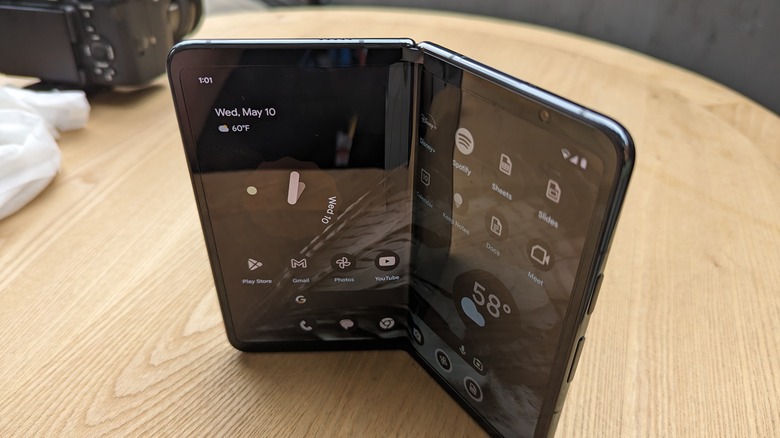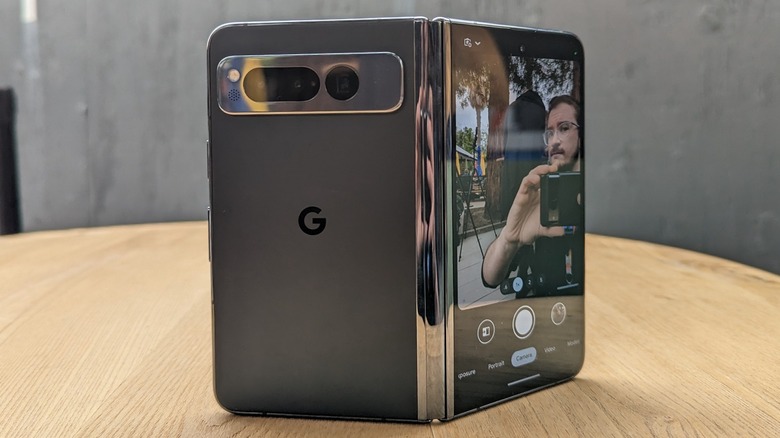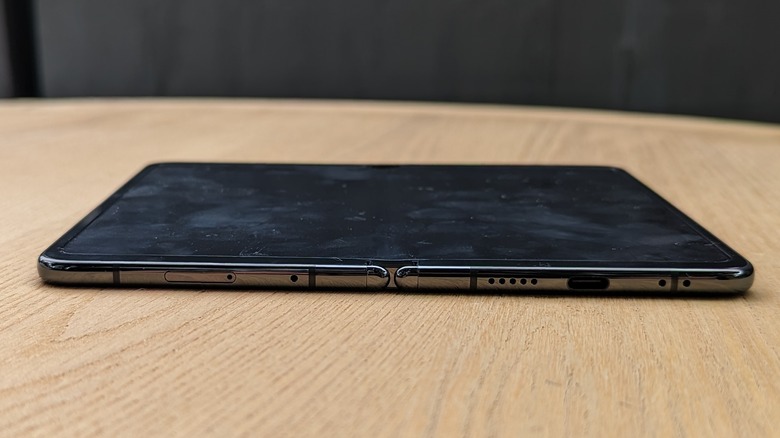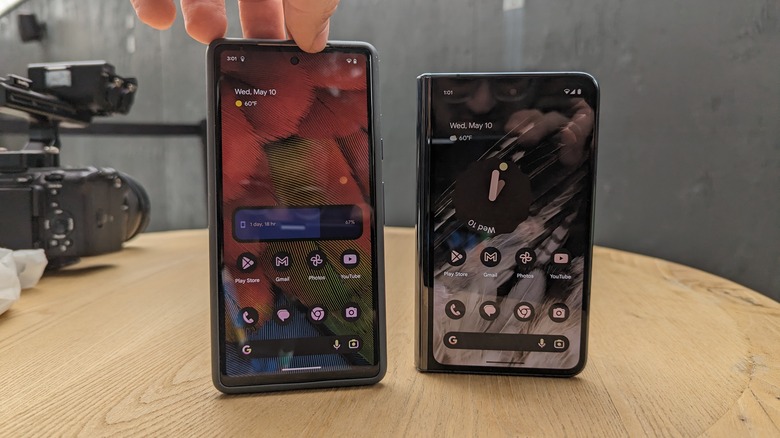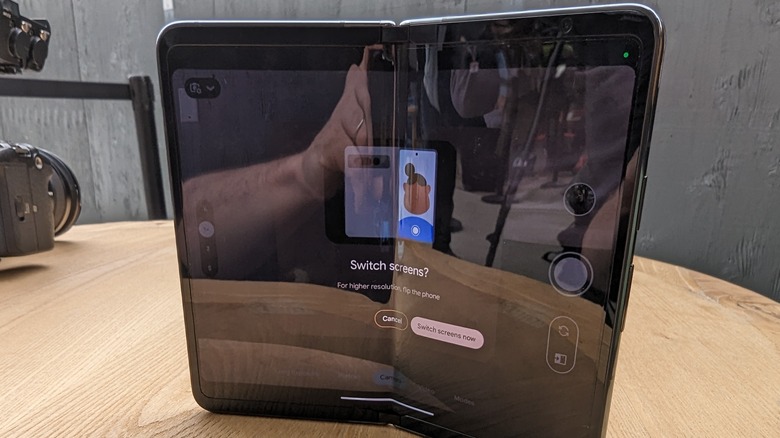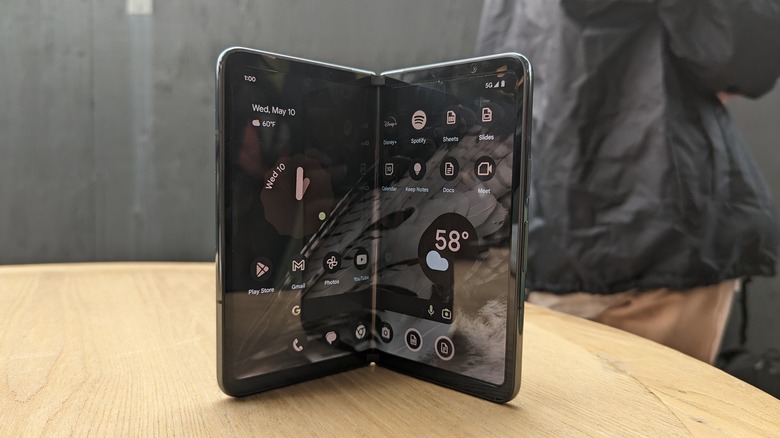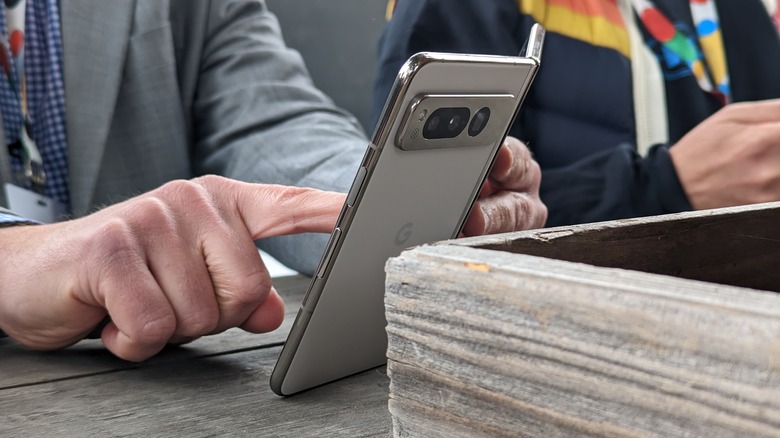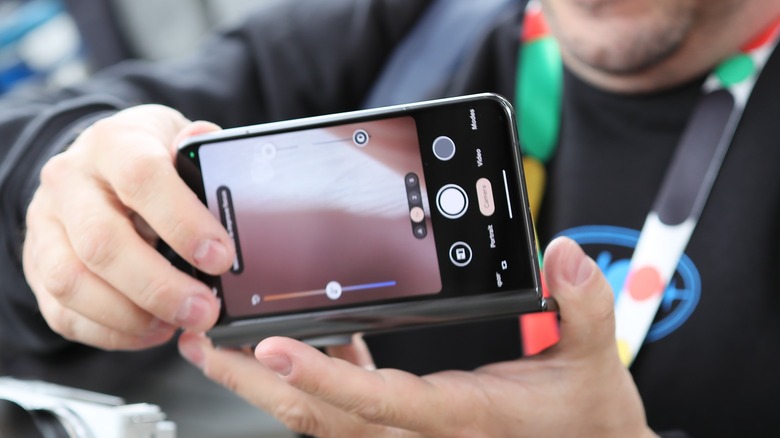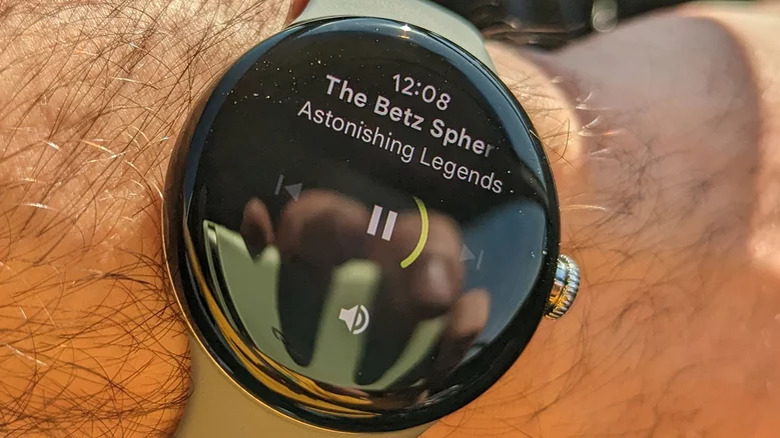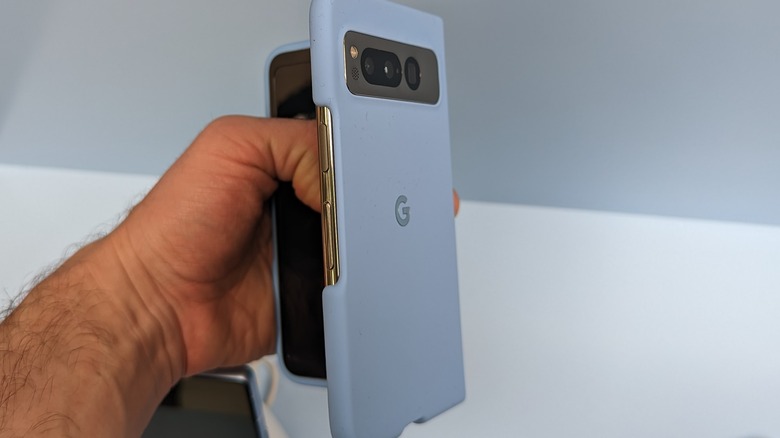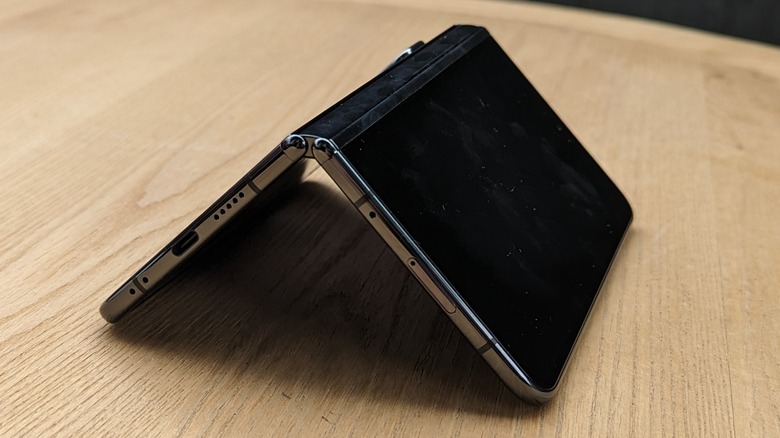Google Pixel Fold Features That Make The Foldable Phone Worth Buying
Ever since Samsung dropped the first Galaxy Z Fold in 2019, foldables have been the bleeding edge of the Android market. Now, Google itself has entered the fray with its newly announced Pixel Fold, and it seems poised to be one of the year's hottest smartphones.
As evidenced by its eye-watering $1,799 price tag, Google is aiming for the fences with the Pixel Fold. There are newly designed hinges, which place much of the mechanism above and below the inner display to allow for a fully flat fold when closed. The build quality overall is among the most premium on the market. Combine that with the Pixel lineup's proprietary software, legendary camera performance, and compatibility with the rest of Google's extensive ecosystem, and you've got a contender for the best foldable currently available.
For those who are sick of the rote, repeatable candy bar-style phones we've grown accustomed to for the better part of two decades and who may now be eyeing the explosion of foldable phones, you may be happy you waited. There are plenty of reasons to think the Google Pixel Fold is the foldable worth buying.
Pixel Fold is the only foldable with Google's exclusive features
One of the best reasons to buy a Pixel device has always been Google's exclusive version of Android, which comes packed with goodies straight from the company that makes the globally dominant mobile OS. That remains true of the Pixel Fold, which is getting a few of its own unique features in addition to those Pixel fans know and love.
There are the tried-and-true Pixel exclusive features such as What's Playing, which passively scans for playing music and displays the song and artist on the always-on display, and Google's proprietary voice recorder app that has nearly flawless onboard transcription and can even differentiate between different speakers in a recording.
Then you'll get Google's top-notch photography tricks, like Magic Eraser, which lets users quickly remove objects or people from photos and intelligently guesses at what should fill that space instead.
But exclusive to the fold are features that take advantage of its unique form factor. Google showed off something it calls Dual Screen, a language translation feature which lets users face the Fold's outer display toward another person and have their voice translated into text on that display. Other Pixels have a similar feature, but you have to awkwardly show your phone to the other person, so this should allow for more seamless scaling of the language barrier when you need to quickly get directions from a local while on vacation. It won't be dropping until this fall according to Google.
There's also an onscreen dock that can be accessed by long pressing the gesture bar, a selfie mode that utilizes the main cameras, and more.
Pixel Fold has a unique and premium design
Software is where Google has always excelled. It is first and foremost a software company, and its hardware can often resemble development platforms rather than consumer-focused luxury goods. But with the Pixel Fold, there's no question that Google has focused on every aspect of the hardware, and the result — so far as we can tell ahead of a full review — is nothing short of stunning.
Ignore the chunky top and bottom bezels, or at least try to, because they exist for a reason. To allow the phone to fold fully flat, as opposed to a device like Samsung's Galaxy Z Fold 4 that closes with a slight gap, Google's product team placed some of the hinge elements into those top and bottom bezels. The result is that the Pixel Fold achieves an IPX8 water resistance rating. According to tech reviewer Michael Fisher, a Google representative informed him that the hinge design bifurcates the device into two halves, allowing water to free-flood through the middle without penetrating into the internals. Additionally, the closed-flat design should do a better job of keeping dust and debris from getting onto the interior display while the device is pocketed.
Then there's the form factor. According to Fast Company, Google was inspired by a Moleskine notebook and a vintage cigarette case. It's certainly unique compared to other tablet-style foldables on the North American market, most closely resembling Oppo's Find N line. Its squatter and unfolds into a widescreen aspect ratio and does indeed resemble a small notebook. Built with Gorilla Glass and stainless steel, the Pixel Fold is among the most premium designs on the foldable market.
An odd-looking, yet usable front display
Unlike foldable phones offered by mainstream players like Samsung, Huawei, Xiaomi, and Vivo, Google is taking a more functionally usable approach with the screen, especially the outer cover display. The Pixel Fold's 5.8-inch external display has a rather odd 17.4:9 aspect ratio, but in the realm of foldable phones, it gives the impression of a fairly regular smartphone screen compared to the likes of the Galaxy Z Fold 4. Samsung's foldable flagship offers a tall 23.1:9 OLED display on the front.
The narrow profile makes it easier to hold the thick phone in the palm of one's hand, but in doing so, the screen also offers an extremely cramped UI experience. App elements look crushed, and letterboxing is the norm. While running games, you will come across lost on-screen content.
The Pixel Fold appears to do away with the app scaling problems. Plus, Google has also done notable work on optimizing its mobile OS for large-screen devices ever since Android 12L and continued that streak with Android 13 and Android 14. With the Pixel Fold, all those software-side optimizations will be in full view for users to savor, irrespective of the screen they're staring at.
Unsightly, but meaningful bezels
Nobody likes bezels. In the smartphone industry, the general consensus is that the thinner they are, the better. But that formula only applies to your average glass slab-style smartphone. And even then, the phone must have really good palm rejection and edge detection systems. Otherwise, ghost touches alongside the edges are fairly common and extremely frustrating, especially when edge gesture controls are enabled.
In the realm of tablets or large-screen devices like foldable phones, bezels are no longer disposable. They become a necessity because they help provide a stronger grip alongside the edges when you're holding the device with one hand only. Foldable phones are smaller than tablets, but the lack of bezels makes one-handed usage really uncomfortable.
Google, thankfully, took the thoughtful path with the Pixel Fold by retaining the bezels to offer a reassuring in-hand feel. Yes, it may not look sleek, but when it comes to enjoying a comfortable experience and the risk of dropping a $1,800 phone, the bezels are the preferrable alternative.
Software support in a league of its own
Google's Pixel phones have never had the reputation of being value-for-money champions. That title is reserved for Chinese brands like OnePlus. However, Google tries to make up for that hardware laggardness with some irresistible promises on the software side. Exclusive features, as mentioned above, are a delicious draw for Pixel phones. However, Google also takes pride in the update longevity for its phones.
Take for example the Pixel Fold, which comes with the promise of software updates for an impressive five years. That's still the best figure that the Android ecosystem has to offer. Plus, you can rest assured that your Pixel Fold will get yearly Android OS upgrades for at least three generations. Or to put it in plain words, your foldable phone will feel fluid and brimming with the latest Android tricks for the next three years at least.
Now, software updates are not just about fancy UI redesigns and new features. They also bring security protections, safeguarding your phone from the barrage of malware and OS vulnerabilities that can leave the doors for anything from data theft and malware injection to surveillance. There's already a ton of precedent for that out there, so it's always safe to bank on the side where security is a guaranteed privilege.
These cameras mean business
The biggest selling point for Pixel smartphones has arguably been their camera experience. Over the years, the competition has caught up with Google's AI imaging wizardry, but to this day, the camera experience of a Pixel smartphone remains a cut above the rest. Even the budget-centric Pixel A-series phones consistently click photos with realistic color profiles, especially at capturing the skin tone, in addition to great dynamic range, and a terrific low-light photography output.
Google didn't cut any major corners with the Pixel Fold's camera hardware. In fact, the company armed its foldable phone with a 5x lossless zoom camera, matching the range that you would get with the Pixel 7 Pro's telephoto camera. Right now, there is no foldable phone in the market that can beat the Pixel Fold at its optical zoom game. To put that into the Apple perspective, a heavy-hitter like the iPhone 14 Pro Max taps out at 3x optical zoom range.
The main camera isn't shabby either, as it relies on a 48-megapixel optically-stabilized sensor, sitting alongside a 10.8-megapixel ultrawide-angle snapper. Notably, you can capture 4K 60FPS videos with both the selfie and rear cameras. However, it's really the exclusive camera features and the AI-assisted tricks that lift the Pixel Fold even above mainstream flagship phones.
The ecosystem is ready, for a price
One recurring argument that Apple loyalists tout is a rewarding hardware ecosystem that ties it all together with an Apple account. Google doesn't quite offer the same from a computing perspective, but with the Pixel Fold, you already have access to top-tier in-house wearable experiences.
Let's start with the Pixel series earbuds. You get to enjoy spatial audio for an immersive listening experience, just in case you felt missing out on the audio perk that the AirPods Pro brings to the table. Fast pairing takes away the hassle of fiddling with Bluetooth settings, while the ear seal check feature ensures that the sound you get from the Pixel Buds is tuned to your ears, quite literally.
You also get the Find My Device convenience, which works both ways between a Google phone and TWS earbuds. Then you have a real-time translation facility for over 40 languages. Google also provides multi-point connectivity, which means you can effortlessly audio routing between your phone and PC. Moreover, if you want the best of the Google Assistant and its hands-free control facilities, the Pixel Buds are your best bet.
Then there's the Pixel Watch, which puts the Google Assistant at its peak functional form on your wrist. Google Wallet support ensures that you can pay with the Google smartwatch, while deep Fitbit integration serves the best fitness tricks right out of the box. Google has also ported over a custom Maps experience to the Pixel Watch, and will even let you control your smart home devices with the smartwatch.
Pixel watch experience at no cost
Look, the Pixel Fold is not a cheap phone at $1,800, even by flagship smartphone standards. The only other device that matches its asking price is Samsung's own Galaxy Z Fold 4. But Google is currently extending a pre-order deal that bundles the Pixel Watch with Pixel Fold pre-orders, which makes the phone's price tag a bit palatable from a value perspective.
The Pixel Watch itself starts at $349, just in case you're curious about the magnitude of savings with Google's offer. If you've been on the fence about splurging that amount on a smartwatch that doesn't bear the Apple branding, and also happens to be a first-gen smartwatch attempt, you can technically get it for free until June, assuming the Pixel Fold is already on your shopping cart.
Now, the Pixel Watch hasn't raced ahead of the Apple Watch, but it has its own set of exclusive perks. To start, it looks stunning, especially with those sloping glass sides on a round frame. The tight integration with Google's ecosystem and the steady progress made with the WearOS platform adds a lot of legitimate software pizzazz to this smartwatch. "Google has delivered a wearable smart device that the average person will find worth wearing," wrote SlashGear editor Chris Burns in his review of the Pixel Watch.
Good battery life on a foldable, finally!
A foldable phone comes with the promise of offering a phone and tablet experience in the same package. As cool as that sounds, running two screens with the same size battery as a regular phone isn't easy. Foldable phones already struggle with internal space, tagging alongside performance and software-side optimization hassle to maximize the power efficiency. Even the likes of Samsung haven't been able to crack that formula after four generations of selling foldable phones.
Google hasn't achieved any engineering breakthrough with the Pixel Fold, as the phone still comes armed with a fairly modest 4,821 mAh battery. However, Google is confidently promising a 24-hour battery life for its first foldable outing. If you enable the extreme battery-saving settings, the screen-on figures will stretch all the way up to 72 hours. Now, these figures touted by brands come with caveats and lab test conditions that don't accurately reflect every person's real-life usage patterns.
But this time around, Google's battery claims hold some substance. Not only is Google in full control of the software here but also has command over the self-designed Tensor G2 processor powering the Pixel Fold. It would be unwise to make a bold statement here prior to a full-fledged review, but the Pixel Fold offers a unique combo of tight software and hardware control to Google that only the likes of Apple enjoy, something that at least signals toward a better-than-average battery life. Plus, wireless charging support is available, too.
Synergic longevity for software and hardware
Google wasn't stingy at engineering the Pixel Fold, even though the endeavor ballooned the phone's cost all the way up to $1,800. But combined with long-term software support promise and high-quality build materials, you can rock the phone for at least two to three years. Or that's what Google is hoping to deliver.
The company put Corning's Gorilla Glass Victus on the phone's cover display as well as the rear panel, while the inner foldable display is shielded by what Google calls "ultra-thin glass with protective plastic layer" on top. The metallic frame is built out of polished aluminum frame while the hinge parts are crafted out of stainless steel. You also get IPX8-level water resistance with the Pixel Fold, which isn't the best out there, but still great to have with the delicate foldable phone hardware.
Do keep in mind that Google isn't promising any "waterproof or dustproof" assurance for the Pixel Fold, and makes it clear that mechanical events like dropping it on the floor could impact its water resistance. On the positive side, Google is also offering a warranty worth a full calendar year with the phone. But if you live in the U.K., Google has you covered for two years.
